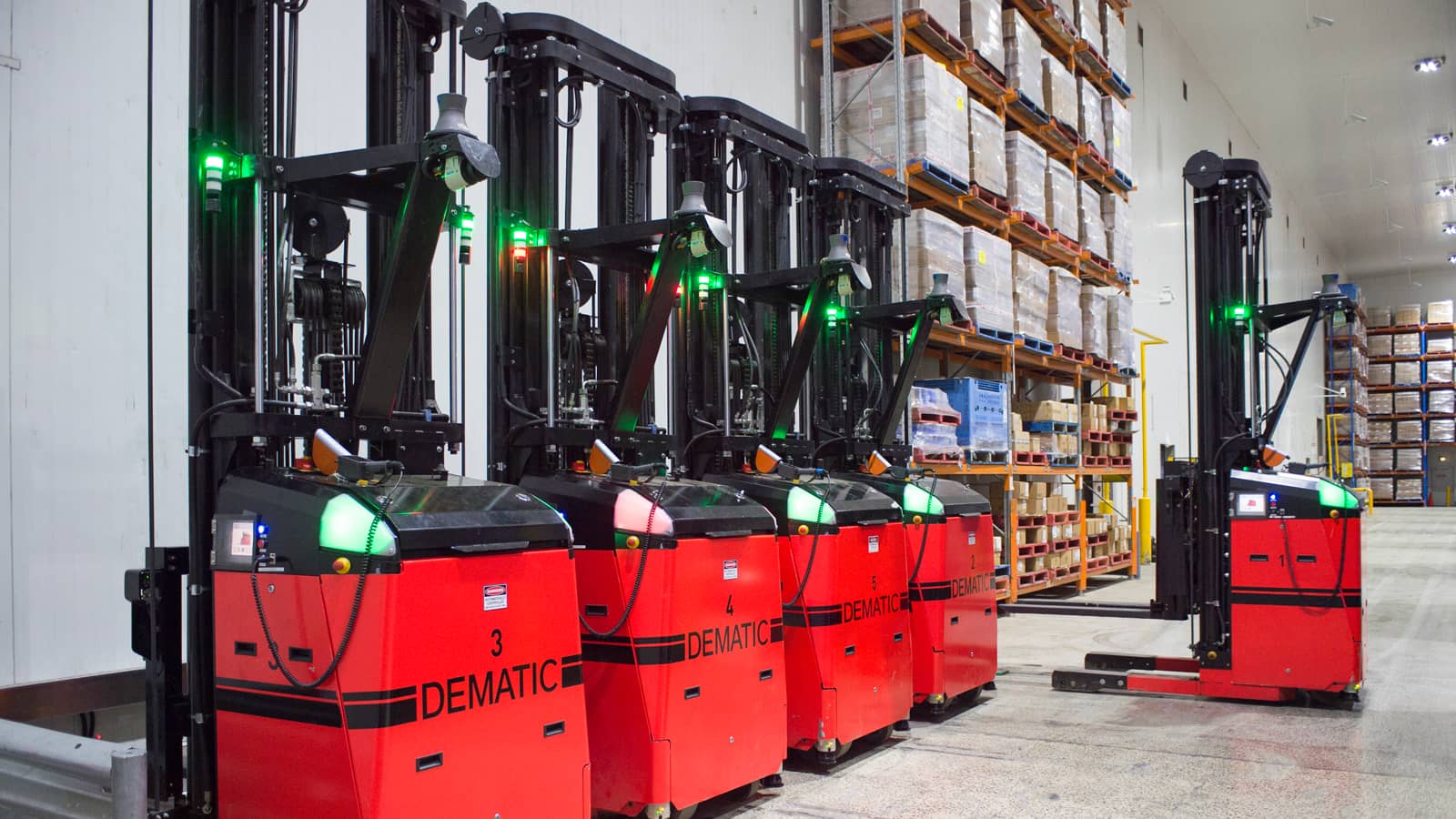Dematic AGVs the coolest solution for Oxford Cold Storage

Oxford Cold Storage was established in 1975, initially to serve neighbouring meat producers, with the first freezer erected adjacent to the poultry processing plant, Cambridge Poultry Distributors. Over the years the business has evolved to offer services to processed food manufacturers, food importers & exporters, and pharmaceutical companies. Management has developed systems and invested heavily in technology in order to provide the best service possible.
Investing in Dematic AGVs
The decision to trial Dematic’s Automatic Guided Vehicles (AGVs) stemmed from the reality of a constant stream of cost pressures. With retailers dropping prices for their consumers, flow-on austerity down the chain meant tighter margins for 3PL companies like Oxford Cold Storage.
“AGVs became an attractive option when we realised the long-term savings we could gain,” said Mark Fleiszig, Chief Information Officer at Oxford Cold Storage. “AGVs can operate around the clock and run at night with the lights out in the freezer warehouse, which has a temperature of minus 25 degrees Celsius. The addition of AGVs in the warehouse meant a reduction in occupational health and safety concerns as well as eliminating human error.”
With 175,000 pallets, a million cubic meters of storage, and a workforce of 400-500, Oxford Cold Storage plans to roll out AGVs in stages, with the aim of eventually using them to handle 90 percent of its freight.
“We have five AGVs currently being tested, they will replace four manual forklifts and operate in a 7,000-pallet fridge,” said Mark. “But moving to AGVs doesn’t mean sacrificing the problem-solving abilities of human operators. We’re hoping to replicate the flexibility we have now with the manual warehouse, but with automation.”
The set-up
Oxford Cold Storage chose to implement AGVs into an existing warehouse rather than build a fully automated warehouse, which, while potentially saving them millions, raised a few challenges. In order to ensure the warehouse was suitable for AGVs every inch of the work space had to be surveyed, mapped and digitised.
The AGVs used in Oxford’s warehouse work by laser guidance. A laser scanner on top of the AGV measures angles and distances to reflectors mounted on the walls and on the racking. The vehicle then triangulates where it is in the warehouse and moves to its programmed position accordingly, with an accuracy of +/- 5.0 mm.
There are strict requirements for the cleanliness and condition of the floors and racking when AGVs are in use. The AGVs will transport standard pallets of 1,165 mm x 1,165 mm, with a maximum pallet weight (including pallet) of 1,300 kg. The pallets need to be undamaged and free of any protruding nails, rubbish and overhang, to avoid confusing the AGV sensors.
To check tolerances and streamline the operation, a production line system will be implemented, where pallets will be offloaded from the truck by manual forklift, then taken to a conveyor to be scanned and profiled. The variability of stock can present some added complications.
“Being a 3PL, we have little control over what we receive,” said Mark. “We just have to deal with it. And the way we deal with it now in a manual operation will need to be adapted when using the AGVs.” Once accepted, the pallets are labelled – they go to the main chamber, where the AGVs pick them and take them to the racking. Programming the AGVs to do what you want them to do is one of the biggest tasks.
Unlike many other companies, Oxford Cold Storage runs its own warehouse management software, rather than a third-party system. So, establishing clear lines of communications between the Oxford Cold Storage WMS and the AGVs software has been an essential part of getting the whole system running.
“The idea is to drive the systems through the in-house WMS only, to maintain consistency and avoid having to re-train operators on using new software,” said Mark. “The conveyor system interfaces with the AGV system, then you’ve got our WMS that interfaces with both systems.”
Introducing robots to the warehouse
The model of the five AGVs being trialled is called the HR-1300-94 SSRF, and they are designed specifically for the requirements of the Oxford Cold Storage warehouse. The AGVs are 3,825 mm high, 2,560 mm long, weigh a massive 5,800 kg each, and can lift to a height of more than nine meters.
There are three AC motors: drive, steer and lift. The AC drives convert DC power from the battery to three-phase AC power. The AGV controller manages all major functionality.
The batteries are special-purpose LED gel, capable of receiving a high current charge and sealed for life. The vehicle will take itself to its charger when it needs to. The charger consists of a charge plate on the floor, where it will connect with the vehicle-mounted charge shoe. There is a manual control device on every AGV, allowing it to be taken out of service for maintenance, or whenever manual operation may be required.
A touch screen operator control panel provides information such as battery status, navigation and position status, fault identification, and speed settings.
An exciting time for automated logistics
Once up and running, the five AGVs in this freezer warehouse will move around 500 pallets per day in a single shift operation, eventually increasing to 4,000 pallets in a 24-hour period.
“By stress testing the system in an isolated environment that won’t cause disruptions to usual business operations, we hope to learn exactly what AGVs are capable of, especially in a freezer environment, and what the future holds for automated logistic solutions.”
